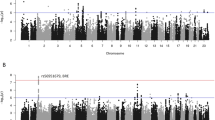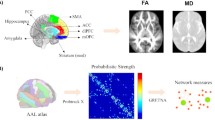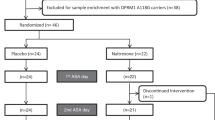Abstract
We examined HPA axis response to 50 mg oral naltrexone compared with placebo in 17 healthy male and female nonalcoholic subjects, approximately half of whom had a positive family history of alcoholism (FH+) and half of whom who did not (FH−). Mood response and naltrexone biotransformation were also examined at various intervals. Subjects participated in two morning test sessions (50 mg naltrexone or identical placebo pill) after an overnight stay in the Rockefeller University GCRC. For the total sample, ACTH and cortisol significantly increased after naltrexone compared with placebo (p < .05). Secondary analyses showed the FH+ subgroup had a different pattern of response over time compared with the FH− subgroup, with heightened ACTH and cortisol, and decreased vigor ratings, during naltrexone (p < .05). The results demonstrate that orally administered naltrexone acutely disinhibits the HPA axis, and that individuals with an assumed greater biological vulnerability to addiction, by virtue of familial alcoholism, had altered regulation of the HPA axis in part under the control of the endogenous opioid system. 166 words.
Similar content being viewed by others
Log in or create a free account to read this content
Gain free access to this article, as well as selected content from this journal and more on nature.com
or
References
Anton RF, Moak DH, Waid LR, Latham PK, Malcolm RJ, Dias JK . (1999): Naltrexone and cognitive behavioral therapy for the treatment of outpatient alcoholics: results of a placebo-controlled trial. Am J Psychiatry 156: 1758–1764
Bohn MJ, Krahn DD, Staehler BA . (1995): Development and initial validation of a measure of drinking urges in abstinent alcoholics. Alcohol Clin Exp Res 19: 600–606
Bond C, LaForge KS, Tian M, Melia D, Zhang S, Borg L, Gong J, Schluger J, Strong JA, Leal SM, Tischfield JA, Kreek MJ, Yu L . (1998): Single nucleotide polymorphism in the human mu opioid receptor gene alters beta-endorphin binding and activity: Possible implications for opiate addiction. Proc Natl Acad Sci 95: 9608–9613
Cahalan V, Cisin I, Crossley HM . (1969): American Drinking Practices. New Jersey, Rutgers Center for Alcohol Studies
Cohen MR, Cohen RM, Pickar D, Weingartner H, Murphy DL . (1983): High-dose naloxone infusion in normals. Arch Gen Psychiatry 40: 613–619
Conaglen JV, Donald RA, Espiner EA, Livesey JH, Nicholls MG . (1985): Effect of naloxone on the hormone response to CRF in normal man. Endocr Res 11: 39–44
Cone EJ, Gorodetzky CW, Yeh SY . (1974): The urinary excretion profiles of naltrexone in man. Drug Metab Dispos 2: 506–512
Cushman P, Kreek MJ . (1974): Some endocrinologic observations in narcotic addicts. In Zimmerman E, George R (eds), Narcotic and the Hypothalamus. New York, Raven Press, pp 161–173
Davidson D, Swift R, Fitz E . (1996): Naltrexone increases the latency to drink alcohol in social drinkers. Alcoholism: Clinical and Experimental Research 20: 732–739
Delitala G, Trainer PJ, Fanciulli G, Grossman AB . (1994): Opioid peptide and α-adrenoceptor pathways in the regulation of the pituitary-adrenal axis in man. J Endocrinol 141: 163–168
Ewing JA . (1984): Detecting alcoholism: The CAGE questionnaire. JAMA 252: 1905–1907
Farren C, O'Malley S, Grebski G, Maniar S, Porter M, Kreek MJ . (1999): Variable dose naltrexone-induced hypothalamic-pituitary-adrenal stimulation in abstinent alcoholics: A preliminary study. Alcohol Clin Exp Res 23: 502–508
First MB, Spitzer RL, Gibbon M, Williams JBW . (1995): Structured Clinical Interview for DSM-IC Axis I Disorders – Patient Edition (SCID-I/P, Version 2.0). New York, Biometrics Research Department
Fujimoto JM, Roerig S, Wang RI, Chatterjie N, Inturrisi CE . (1975): Narcotic antagonistic activity of several metabolites of naloxone and naltrexone testing in morphine dependent mice. Proc Soc Exp Biol Med 148: 443–448
Gianoulakis C, Beliveau D, Angelogianni P, Meaney M, Thavundayil J, Tawar V, Dumas M . (1989): Different pituitary β-endorphin and adrenal cortisol response to ethanol in individuals with high and low risk for future development of alcoholism. Life Sci 45: 1097–1109
Gianoulakis C, Krishnan B, Thavundayil J . (1996): Enhanced sensitivity of pituitary β-endorphin to ethanol in subjects at high risk of alcoholism. Arch Gen Psychiatry 53: 250–257
Gonzalez JP, Brogden RN . (1988): Naltrexone: A review of its pharmacodynamic and pharmacokinetic properties and therapeutic efficacy in the management of opioid dependence. Drugs 35: 192–213
Heatherington TF, Kozlowski LT, Frecker RC, Fagerström KO . (1991): The Fagerström Test for nicotine dependence: a revision of the Fagerström tolerance questionnaire. Br J Addict 86: 1119–1127
Johnson EO, Kamilaris TC, Chrousos GP, Gold PW . (1992): Mechanisms of stress: a dynamic overview of hormonal and behavioral homeostasis. Neurosci Biobehav Rev 16: 115–130
King AC, Schluger J, Disla I, Kreek MJ . (1998): Acute neuroendocrine effects of oral naltrexone in family history positive and negative social drinkers. Alcoholism: Clinical and Experimental Research 22: 120A
King AC, Volpicelli JR, Gunduz M, O'Brien CP, Kreek MJ . (1997a): Naltrexone biotransformation and incidence of subjective side effects: a preliminary study. Alcohol Clin Exp Res 21: 906–909
King AC, Volpicelli JR, Frazer A, O'Brien CP . (1997b): Effect of naltrexone on subjective alcohol response in subjects at high and low risk for future alcohol dependence. Psychopharmacology 129: 15–22
Koob GF . (1999): Stress, corticotropin-releasing factor, and drug addiction. Ann N Y Acad Sci 897: 27–45
Kosten TR, Kreek MJ, Raghunath J, Kleber HD . (1986a): Cortisol levels during chronic naltrexone maintenance treatment in ex-opiate addicts. Biol Psych 21: 217–220
Kosten TR, Kreek MJ, Raghunath J, Kleber HD . (1986b): A preliminary study of beta-endorphin during chronic naltrexone maintenance treatment in ex-opiate addicts. Life Sci 39: 55–59
Kranzler HR, Modesto-Lowe V, Van Kirk J . (2000): Naltrexone vs. nefazodone for treatment of alcohol dependence: a placebo-controlled study. Neuropsychopharmacology 22: 493–503
Kreek MJ . (1972): Medical safety, side effects, and toxicity of methadone. Proceedings of the Fourth National Conference on Methadone Treatment, National Association for the Prevention of Addiction to Narcotics, New York, pp 171–174
Kreek MJ . (1973): Physiological implications of methadone treatment. Proceedings of the Fifth National Conference of Methadone Treatment. National Association for the Prevention of Addiction to Narcotics, pp 85–91
Kreek MJ . (1978): Medical complications in methadone patients. Ann NY Acad Sci 311: 110–134
Kreek MJ . (1992): Rationale for maintenance pharmacotherapy of opiate dependence. In O'Brien CP, Jaffe JH (eds), Addictive States. Association for Research in Nervous and Mental Disease, Vol. 70. New York, Raven Press, pp 205–230
Kreek MJ . (2000): Opiates, opioids, SNPs and the addictions: Nathan B. Eddy Memorial Award for lifetime excellence in drug abuse research lecture. In Harris LS (ed), Problems of Drug Dependence, 1999; Proceedings of the 61st Annual Scientific Meeting of the College on Problems of Drug Dependence. National Institute of Drug Abuse Research Monogaph Series. Washington, D.C.: Supt. of Docs., U.S. Govt. Print. Off., DHHD Pub. No. (ADM)00-4737, 180: 3–22
Kreek MJ, Raghunath J, Plevy S, Hamer D, Schneder B, Hartman N . (1984): ACTH, cortisol, and beta-endorphin response to metyrapone testing during chronic methadone maintenance treatment in humans. Neuropeptides 5: 277–278
Kreek MJ, Schneder BS, Raghunath J, Plevy S . (1984): Prolonged (24 hour) infusion of the opioid antagonist naloxone does not significantly alter plasma levels of cortisol and ACTH in humans. Abstracts of the seventh international congress of endocrinology, Excerpta Medica, International congress series 652, Amsterdam-Oxford-Princeton: 845
LaForge KS, Shick V, Spangler R, Proudnikov V, Lysov Y, Mirzabekov A, Kreek MJ . (2000): Detection of single nucleotide polymorphisms of the human mu opioid receptor gene by hybridization or single nucleotide extension on custom oligonucleotide gelpad microchips: Potential in studies of addiction. Neuropsychiatric Genetics 96: 604–615
Levenson RW, Oyama ON, Meek PS . (1987): Greater reinforcement from alcohol for those at risk: parental risk, personality risk, and gender. J Abnorm Psychol 96: 242–253
Mangold DL, Peyrot M, Giggey P, Wand GS . (2000): Endogenous opioid activity is associated with obsessive-compulsive symptomology in individuals with a family history of alcoholism. Neuropsychopharmacology 22: 595–607
Martin del Campo AE, Dowson JH, Herbert J, Paykel ES . (1994): Effects of naloxone on diurnal rhythms in mood and endocrine function: a dose-response study in man. Psychopharmacology (Berl) 114: 583–590
McCaul ME, Wand GS, Rohde C, Lee SM . (2000): Serum 6-beta-naltrexol levels are related to alcohol responses in heavy drinkers. Alcohol Clin Exp Res 24: 1385–1391
McNair DM, Lorr M, Droppleman LF . (1971): Manual for the Profile of Mood States. San Diego, Educational and Industrial Testing Service
Mendelson JH, Ellingboe J, Keuhnle JC, Mello NK . (1978): Effects of naltrexone on mood and neuroendocrine function in normal adult males. Psychoneuroendocrinology 3: 231–236
Morley J, Baranetsky NG, Wingert TW, Carleson HE, Hershman JM, Melmed S, Levin SR, Jamison KR, Weitzman R, Chang J, Varner AA . (1980): Endocrine effects of naloxone-induced opiate receptor blockade. J Clin Endocrinol Metab 50: 251–257
Naber D, Pickar D, Davis GC, Cohen RM, Jimerson DC, Elchisak MA, Defraites EG, Kalin NH, Risch SC, Buchsbaum MS . (1981): Naloxone effects on b-endorphin, cortisol, prolactin, growth hormone, HVA, MHPG, in plasma of normal volunteers. Psychopharmacol 74: 125–128
O'Malley SS, Krishnan-Sarin S, Farren C, Sinha R, Kreek MJ . (2001): Naltrexone decreases craving and alcohol self-administration in alcohol dependent subjects and activates the hypothalamo-pituitary-adrenocorticol axis. Psychopharmacol (in press).
O'Malley SS, Carey KB, Maisto SA . (1986): Validity of young adults’ reports of parental drinking practices. J Stud Alcohol 47: 433–435
O'Malley SS, Jaffe A, Chang G, Shottenfeld RS, Meyer RE, Rounsaville B . (1992): Naltexone and coping skills therapy for alcohol dependence: a controlled study. Arch Gen Psych 49: 881–887
Peterson JB, Pihl RO, Gianoulakis C, Conrod P, Finn PR, Stewart SH, LeMarquand DG, Bruce KR . (1996): Ethanol-induced change in cardiac and endogenous opiate function and risk for alcoholism. Alcohol Clin Exp Res 20: 1542–1552
Pokorny AD, Miller BA, Kaplan HB . (1972): The brief MAST: a shortened version of the Michigan alcoholism screening test. Am J Psychiatry 129: 342–345
Schacham S . (1983): A shortened version of the profile of mood states. J Pers Assess 47: 305–306
Schluger J, Ho A, Porter M, Maniar S, Gunduz M, Perret G, King A, Kreek MJ . (1998): Nalmefene causes greater hypothalamic-pituitary-adrenal axis activation than naloxone in normal volunteers: implications for the treatment of alcoholism. Alcohol Clin Exp Res 22: 1430–1436
Schuckit MA, Gold EO . (1988): A simultaneous evaluation of multiple markers of ethanol/placebo challenges in sons of alcoholics and controls. Arch Gen Psych 45: 211–216
Schuckit MA, Gold E, Risch C . (1987): Plasma cortisol levels following ethanol in sons of alcoholics and controls. Arch Gen Psych 44: 942–945
Schuckit MA, Risch SC, Gold EO . (1988): Alcohol consumption, ACTH level, and family history of alcoholism. Amer J Psychiatry 145: 1391–1395
Schuckit MA, Tsuang JW, Anthenelli RM, Tipp JE, Nurnberger JI . (1996): Alcohol challenges in young men from alcoholic pedigrees and control families: A report from the COGA project. J Stud Alc 57: 368–377
Sher KJ, Descutner C . (1986): Reports of paternal alcoholism: reliability across siblings. Addict Behav 11: 25–30
Swift RM, Whelihan W, Kuznetsov O, Buongiorno G, Hsuing H . (1994): Naltrexone-induced alterations in human ethanol intoxication. Americal Journal of Psychiatry 151: 1463–1467
Verebey K, Volavka J, Mule SJ, Resnick RB . (1976): Naltrexone: disposition, metabolism, and effects after acute and chronic dosing. Clin Pharmacol Ther 20: 315–328
Volavka J, Cho D, Mallya A, Bauman J . (1979a): Naloxone increases ACTH and cortisol levels in man. N Engl J Med 300: 1056–1057
Volavka J, Mallya A, Bauman J, Pevnick J, Cho D, Reker D, James B Dornbush . (1979b): Hormonal and other effects of naltrexone in normal men. Adv Exp Med Biol
Volpicelli JR, Alterman AI, Hayashida M, O'Brien CP . (1992): Naltrexone in the treatment of alcohol dependence. Arch Gen Psychiatry 49: 876–880
Volpicelli J, Rhines KC, Rhines JS, Volpicelli PA, Alterman Ai, O'Brien CP . (1997): Naltrexone and alcohol dependence: role of subject compliance. Arch Gen Psychiatry 54: 737–742
Wall ME, Brine DR, Perez-Reyes M . (1981): Metabolism and disposition of naltrexone in man after oral and intravenous administration. Drug Metab Dispos 9: 369–375
Wand GS, Mangold D, El Deiry S, McCaul ME, Hoover D . (1998): Family history of alcoholism and hypothalamic opioidergic activity. Arch Gen Psychiatry 55: 1114–1119
Wand GS, Mangold D, Ali M . (1999a): Adrenocorticotropin responses to naloxone in sons of alcohol-dependent men. J Clin Endocrinol Metab 84: 64–68
Wand GS, Mangold D, Ali M, Giggey P . (1999b): Adrenocortical responses and family history of alcoholism. Alcohol Clin Exp Res 23: 1185–1190
Wand GS, McCaul ME, Gotjen D, Reynolds J, Lee S . (2001): Confirmation that offspring from families with alcohol-dependent individuals have greater hypothalamic-pituitary-adrenal axis activation induced by naloxone compared with offspring without a family history of alcohol dependence. Alcohol Clin Exp Res 25: 1134–1139
Waltman C, McCaul B, Wand GS . (1994): Adrenocorticotropin responses following administration of ethanol and ovine corticotropin-releasing hormone in the sons of alcoholics and controls subjects. Alcohol Clin Exp Res 18: 826–830
Acknowledgements
This work was supported by NIH (K05 DA-00049 (MJK), P50 DA05130, R03 AA11001, R03 AA11133 (AK), and M01-RR-00102). The assistance of Irahisa Disla and the staff of the Rockefeller University GCRC is greatly appreciated.
Author information
Authors and Affiliations
Corresponding author
Rights and permissions
About this article
Cite this article
King, A., Schluger, J., Gunduz, M. et al. Hypothalamic-Pituitary-Adrenocortical (HPA) Axis Response and Biotransformation of Oral Naltrexone: Preliminary Examination of Relationship to Family History of Alcoholism. Neuropsychopharmacol 26, 778–788 (2002). https://doi.org/10.1016/S0893-133X(01)00416-X
Received:
Revised:
Accepted:
Published:
Issue date:
DOI: https://doi.org/10.1016/S0893-133X(01)00416-X
Keywords
This article is cited by
-
Stress and pain: modality-specific opioid mediation of stress-induced analgesia
Journal of Neural Transmission (2021)
-
“Killing Two Birds with One Stone”: Alcohol Use Reduction Interventions with Potential Efficacy at Enhancing Self-control
Current Addiction Reports (2014)
-
The genetics of the opioid system and specific drug addictions
Human Genetics (2012)
-
Altered Levels of Basal Cortisol in Healthy Subjects with a 118G Allele in Exon 1 of the Mu Opioid Receptor Gene
Neuropsychopharmacology (2006)
-
The Mu-Opioid Receptor Polymorphism A118G Predicts Cortisol Responses to Naloxone and Stress
Neuropsychopharmacology (2006)



